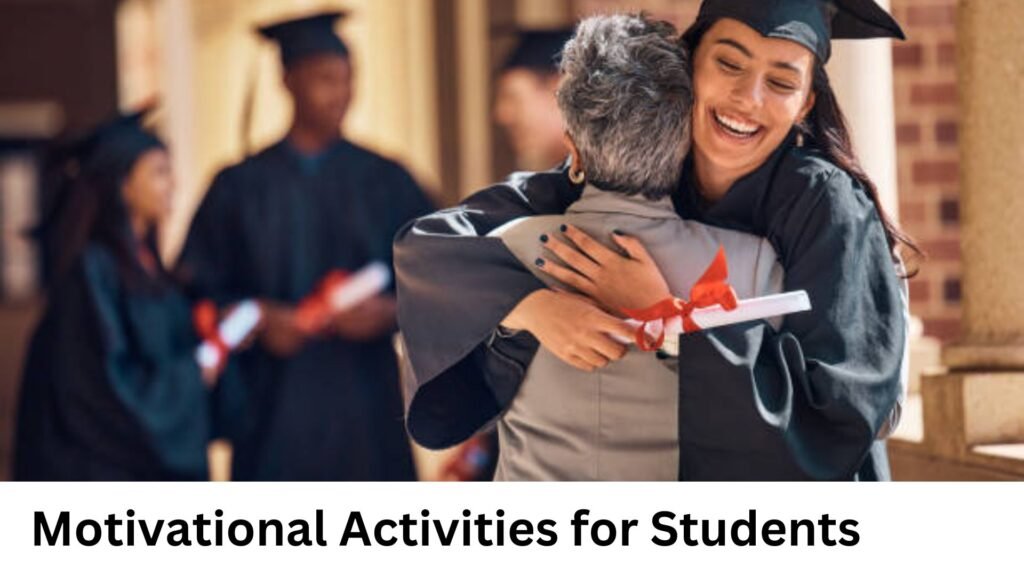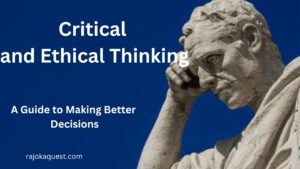Motivational Activities for Students

Motivational Activities for Students
Motivational Activities for Students Motivational activities are essential tools in classroom environments. Motivating activities help generate excitement, involvement, and a good attitude towards learning. Simple classroom exercises and more complex projects are all meant to motivate pupils to realize their best potential. These activities can range from Including inspirational events in the syllabus that will enable teachers to encourage their pupils to grow confident, improve their abilities, and fall in love with studying.
Why do Students Need Motivational Activities?
Students’ overall growth depends heavily on motivating activities. These pursuits help one grow personally and improve one’s academic achievement. Motivated students are more likely to engage actively in class, exhibit interest in their studies, and pursue greatness. Long-term success depends on kids having a growth mindset, setting objectives, overcoming obstacles, and having motivation that helps them accomplish these things.
Various Motivational Activities for Students
Goal-setting Workshop
One promising approach to inspire pupils is through goal-setting seminars. These seminars guide students towards both personally and academically reasonable and attainable goals. Students can keep inspired and monitor their development by separating their goals into doable chores. Frequent assessment and modification of these objectives guarantee students’ continued concentration and dedication.
Games for Interactive Learning
Interactive games are a great and exciting approach to inspiring pupils. These games allow one to customize them to meet different disciplines and ability levels, therefore enhancing the learning process. Interactive games, such as a maths puzzle, a science quiz, or a vocabulary challenge, support friendly rivalry and teamwork among students, therefore promoting a good learning atmosphere.
Inspiring Guest Speakers
Students may find great inspiration in inviting guest speakers to offer their knowledge and experiences. Speakers from many backgrounds—such as accomplished businesspeople, writers, or community leaders—can teach kids great lessons and motivate them to follow their interests. Real-life success stories enable children to appreciate diligence, tenacity, and persistence.
Creative Arts Projects
Projects in creative arts let pupils discover their aptitudes and communicate themselves. Drawing, painting, music, and theatre, among other things, can help one feel confident and accomplished. As children discover how to approach chores imaginatively and think outside the box, these projects help foster critical thinking and problem-solving abilities.
Team-Building Activities
Team-building events depend on the development of communication and teamwork. Group projects, sports, and problem-solving challenges, among other things, help students develop trust, cooperate, and accomplish shared objectives. These encounters help students understand the need to support each other and work together.
Personal Development Workshops
Workshops on personal development focus on acquiring fundamental life skills, including time management, stress control, and good communication. These seminars give students the tools they need to negotiate their personal and academic lives effectively. Students who take care of these areas will be more generally healthy and remain driven to reach their objectives.
Positive Rewards and Reinforcement
Rewards and positive reinforcement will significantly increase student drive. Celebrating and acknowledging successes—no matter how little—helps students to keep working. Rewards might be anything from certificates to little tokens of gratitude to verbal compliments. Regular positive reinforcement contributes to creating a conducive and motivating classroom.
Mentoring Programs
Students enrolled in mentoring programs are matched with mentors capable of offering direction, encouragement, and advice. Mentors might be community leaders, older students, or teachers. For students, these connections provide a feeling of community and someone to consult for guidance and inspiration. Mentorship programs also assist students in identifying and fulfilling their academic and personal goals.
Mindfulness & Meditation Sessions
Mindfulness and meditation exercises can help students manage stress and stay focused. These activities teach students how to be present, quiet their thoughts, and handle obstacles with a positive perspective. Incorporating mindfulness into the school routine can improve children’s attentiveness, emotional management, and overall well-being.
Field Trips and Experiential Learning
Field trips and experiential learning activities allow students to experience different areas and study beyond the classroom. Visiting museums, historical sites, or science centers can spark curiosity and motivate students to learn more about the world around them. These experiences make learning tangible and memorable, encouraging a lifelong love for discovery.
Student-Led Initiatives
Encouraging kids to take the lead on projects and activities promotes a sense of ownership and responsibility. Student-led activities, such as organizing events, founding organizations, or conducting community service initiatives, empower students to make a difference and build leadership abilities. These encounters can be very motivating and fulfilling.
Incorporating Technology
Using technology in the classroom can make learning more interactive and exciting. Multimedia presentations, internet resources, and instructional apps can accommodate several learning environments and maintain students’ interest. Personalized learning experiences made possible by technology enable students to keep motivated and advance at their own pace.
Storytelling and Role Models
For pupils, sharing tales of successful role models can inspire great motivation. Whether through books, videos, or classroom discussions, learning about individuals who have overcome hurdles and succeeded can motivate children to follow their aspirations. Role models offer real-world illustrations of what is possible with diligence and will.
Movement and Physical Exercise
Including physical exercise in the school day helps pupils increase their energy levels and sharpen their attention. Classroom routines can include yoga, dance, or basic stretching exercises. Physical exercise lowers stress and improves general well-being, motivating students and preparing them to learn.
Promoting Intensive Self-examination
Students should be encouraged to consider their educational experiences, which allows them to identify their areas of strength and need for development. Journaling, self-evaluation, and peer comments are valuable instruments for self-reflection. This approach inspires students to take responsibility for their educational path and fosters a growth attitude.
Establishing a Good Classroom Environment
Student motivation cannot exist in a hostile school setting. Teachers can establish this environment by supporting inclusiveness, open communication, and mutual respect. A friendly and encouraging classroom helps kids feel protected and appreciated, therefore increasing their drive to engage and achieve.
Peer Support
One of the most substantial incentives available to students is peer support. Students may learn from and help one another via study groups, peer tutoring, and cooperative projects. This feeling of shared responsibility and community can increase drive and foster a favorable learning environment.
Celebrating Diversity and Inclusion
Acknowledging and appreciating diversity and inclusion in the classroom allows every student to feel appreciated. Activities stressing many cultures, points of view, and experiences help foster empathy and understanding. An inclusive setting inspires kids to value their own identities and drives them to participate significantly in the classroom community.
Including Fun and Play
Learning doesn’t have to be taken very seriously. Including play and fun in instructional activities helps to make learning more exciting and pleasurable. Games, riddles, and creative projects can pique children’s curiosity and inspire them to engage actively in their education.
Providing Opportunities for Student Choice
Giving pupils a voice in their education can increase their involvement and drive. Giving pupils choices in projects, homework, or subjects they wish to investigate helps them take charge of their education. This autonomy motivates students to invest in their education and allows them to feel accountable.
Fostering a growth mindset
Encouragement of a growth mindset in the classroom encourages pupils to realize that work and persistence can lead to the development of intelligence and skills. Encouragement of a concentration on learning and development instead of only grades promotes resilience and a passion for learning. With a growing attitude, students are more inclined to welcome challenges and remain driven.
Engaging Communities and Families
Including families and the community in the learning process helps to raise student inspiration. Parent-teacher conferences, volunteer programs, and school fairs help to foster cooperation and shared accountability. Students are more driven to achieve when they know their relatives and community support their education.
Personalize Learning Programs
Plans for personalized learning fit each student’s particular interests and demands. By customizing the course to suit various learning styles and abilities, teachers can guarantee that every student is challenged and supported. By offering pertinent and significant learning opportunities, personalized learning plans help students remain involved and motivated.
Incorporating Real-World Connections
Linking classroom instruction to practical uses helps students find relevance and inspiration in their studies. Project-based learning, internships, and industry professional guest lectures are a few examples. These relationships encourage students to apply their knowledge in valuable ways and help them appreciate their education.
Encouraging Positive Interactions
Motivation depends on teachers and students developing good relationships. Students who believe their teachers value their well-being and performance are more likely to be involved and driven. Good teacher-student interactions foster a motivating and encouraging classroom.
Encouraging Curiosity and Exploration
Encouraging kids to probe novel concepts and ask questions develops a passion for learning. Science experiments, research projects, and debates—activities that support inquiry-based learning—can inspire students to investigate topics that pique their interests more.
Providing Constructive Feedback
Students’ development and drive depend on constructive criticism. Feedback should point out strengths and provide doable recommendations for development rather than concentrating just on mistakes. This method inspires students to keep aiming for greatness and encourages them to see their development.
Celebrating Achievements
Celebrating both major and minor successes may be pretty motivating. Acknowledging students’ efforts and triumphs through rewards, certificates, or class celebrations helps inspire them to keep on their diligent path. Celebrations in the classroom foster a motivating and pleasant environment.
Encouraging Accountability and Independence
Encouragement of pupils to own their education promotes self-motivation and independence. Giving pupils chances to make decisions, organize their time, and create goals helps them acquire critical life skills. Students who feel in charge of their learning are more driven to achieve.
Establishing a Supportive and Safe Environment
A safe and encouraging classroom depends on students’ motivation. Dealing with bullying, promoting respect, and offering emotional support make pupils feel safe and valued. Students who feel secure are more likely to be engaged actively and to remain motivated.
Promoting Teamwork and Peer Learning
Activities involving peer learning and collaboration help kids develop communication and teamwork skills. Group projects, debates, and peer review meetings let students exchange knowledge and learn from one another. Cooperative learning allows students to feel part of a community and inspires them to participate significantly.
Providing Opportunities for Reflection and Self-Assessment
Students are encouraged to evaluate their development and consider their educational experiences, which fosters self-awareness and drive. Activities such as goal-setting exercises, self-assessment rubrics, and journaling help students identify their areas of strength and areas needing work. This approach inspires students to own their path of learning.
Incorporating social and emotional learning (SEL)
Including social and emotional learning (SEL) in the course enables students to acquire critical abilities for controlling their emotions, fostering relationships, and making moral decisions. Role-playing, mindfulness techniques, and empathy-building exercises, among other SEL activities, help establish an engaging and friendly classroom.
Utilizing Project-Based Learning
Project-based learning helps pupils by involving them in real-world situations and encouraging the practical application of information. This method advances cooperation, critical thinking, and inventiveness. Activities in project-based learning inspire students by offering relevant and significant learning opportunities.
Creating Possibilities for Student Leadership
Giving kids chances to assume leadership positions helps them to be motivated and responsible. Student councils, peer mentoring initiatives, and leadership seminars enable kids to change things and grow personally in their leadership abilities. These encounters inspire students to pursue excellence and show initiative.
Encouraging a Positive School Culture
An excellent educational environment encourages every student to feel enthusiastic and belonging. School-wide projects, including anti-bullying campaigns, celebrations of diversity, and community service projects, foster inclusiveness and support. Students who feel a part of their school community are more driven to achieve.
Encouraging Lifelong Learning
Encouragement of a lifetime love of learning drives pupils to continue their education outside of the classroom. Inquiry, curiosity, and a growth attitude allow pupils to view learning as a lifetime journey. Motivated to learn for the sake of learning, students are more likely to follow their interests and reach their objectives.
Conclusion
An exciting and motivating classroom depends mostly on motivating activities for the pupils. Teachers can significantly increase students’ passion for learning by including several motivating techniques, including goal-setting seminars, interactive learning games, and artistic projects. Maintaining student enthusiasm also depends critically on creating a welcoming and inclusive classroom, motivating self-reflection, and honoring successes. Students who feel respected, understood, and motivated are more likely to engage actively, take on challenges, and realize their most significant potential. By means of these inspiring activities, pupils not only improve their academic performance but also help in their general emotional and personal growth, therefore arming them for lifetime success.
Read more, Click Here



